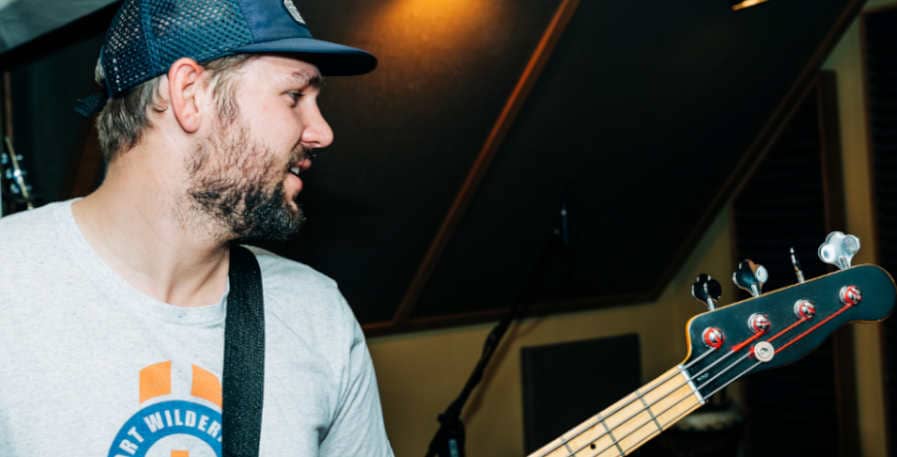Having to constantly hold your bass in place due to neck dive is annoying and cumbersome. While some bassists decide to just live with it, I have always been a big proponent of fixing the neck dive on my basses.
Neck dive is usually caused by the shape of your bass and can thus seem hard to fix. However, there are in fact multiple easy solutions to this problem.
That`s why I`ve written this article so that you can easily fix the neck dive on your bass with minimal effort.
We will start by diagnosing what is most likely causing the neck of the bass to drop in the first place. Then I will give you my 5 best neck dive solutions that you can use to easily solve the issue.
Why does my bass have neck dive?
A bass with neck dive has an uneven weight distribution between the headstock and body. When there is too much weight at the top end of your bass, the center of gravity shifts towards the neck from the body, which causes the neck to dive.
In general, neck dive is a direct result of how the bass is manufactured.
Gibson Thunderbirds, for example, tend to have a good bit of neck dive. Their iconic look comes at the price of placing the upper strap button way down on the body. As a result, this puts more weight on the neck of the bass, which in turn causes neck dive.
Your bass could also have neck dive due to the strap you are using. Another possibility is that the tuning pegs are heavier than they need to be.
These are more likely to be the cause of the dive when the upper strap button is below the height of the 13th fret. This is because the design of your bass is less likely to be the problem. The weight will generally be evenly distributed when the strap button is at this height.

How to fix Bass neck dive
Here are my best neck dive solutions that anyone can make use of.
1. Add weight
A bass with neck dive is like a scale with more weight on one of the sides. Balance the scale, and the problem is solved.
You can do this by adding weight to the body of the bass. Adhesive wheel weights can be attached inside the cavity of your bass.
If you don`t care for the aesthetics, you can even attach them to the back of the body. These are easy to attach, and having multiple strips makes it easy to balance the weight out.
2. Switch tuning pegs –
If your tuning pegs are on the larger side, they might be contributing to the neck dive.
A set of large club-shaped tuning pegs that are common for basses such as the Fender Precision weight 14.5 oz (411g) on a 4-string bass. This set of pegs from Rosenice weighs 8.4 oz (238g) and it will do the same job as a heavier set of pegs.
In terms of neck dive, this will be a significant decrease in weight on the headstock of the bass.
3. Get a better strap
Your bass strap choice affects comfort and playability, but it can also affect neck dive.
A good strap will rarely solve the issue on its own. However, a better strap can be helpful if you want to take every measure possible and also decreases the chance of the neck dive causing back pains.
I recommend this 3.5″ (8.9cm) strap from Lekato. Its thickness combined with the sponge padding will make it grip better on to your body. This will make the weight of your bass feel more even.
4. Move the strap button
This tip will require some DIY work. The upside is that as long as you have a screwdriver available, it`s a completely free solution.
If your upper strap button is not attached at the furthest end of the body, you can unscrew it and reattach it there. You can also do the same to the rear strap button by moving it up the back of the bass. Bear in mind that this will leave a small hole in your bass.
On the upside, this is a great way to fix neck dive. You can attach the buttons where you like, putting you in full control of the balance of the weight.
5. Attach the strap to your belt
This solution does not permanently fix the neck dive. On the other hand, it will make it unnoticeable while you are playing.
Depending on how you want to appear when playing, you might also find that it looks awkward. The upside is that it is a simple and effective solution.
Strap your bass low enough so that you can coil the back end of your strap to your belt. This will keep the bass locked to you which will make the neck dive unnoticeable.
Conclusion
“Get used to it” and “Play a different bass” are disappointingly common answers to neck dive among bassists. In reality, neck dive is a problem that has multiple easy solutions.
I haven`t played bass with neck dive for years, but the last time I did I fixed the problem by adding weights to it. You can do the same, or apply any of the other tips outlined above to fix the problem.
Make sure to diagnose what the likely cause of the neck dive is in the first place before doing so. Are the strap buttons far back on the body of the bass, are the tuning pegs large, or are you using a thin bass strap?
Regardless of what the cause of the issue is, you can find one or more solutions in the list above. Once the neck dive is fixed, you are likely to experience that the bass will feel a lot lighter and more fluid to play.
If a bass with neck dive feels cumbersome to play, there might be multiple issues with it that make the playability of the instrument suffer. It can then be preferable to fix all the issues that make the neck of your bass feel slow. To learn more, read about these 3 ways to make your bass neck faster.

